Translations and commentary of Thich Nhat Hanh’s meditation hall Zen poems.
Our teacher Thay often offered each meditation hall parallel verses,Parallel verses (also know as a couplet) are a form on Vietnamese poetry, each verse has the same number of words, normally ranging from four to seven. Corresponding characters also often have the same lexical category (noun-noun, verb-verb, etc.).created by his own hand. They hang on each side of the main altar and their poetic nature serve as inspiration for our practice.
For the first time, we are offering a translation of these verses from Vietnamese into English followed by a commentary from a Plum Village elder. We hope these verses will give you a small taste of the beauty of Vietnamese Zen poetry.
Assembly of Stars Meditation Hall (Lower Hamlet)
The bubbling creek, stream of Dharma Nectar Rustling of the willow, an assembly of thousands of stars Suối tuôn róc rách dòng cam lộ Dương reo vi vút hội ngàn sao.
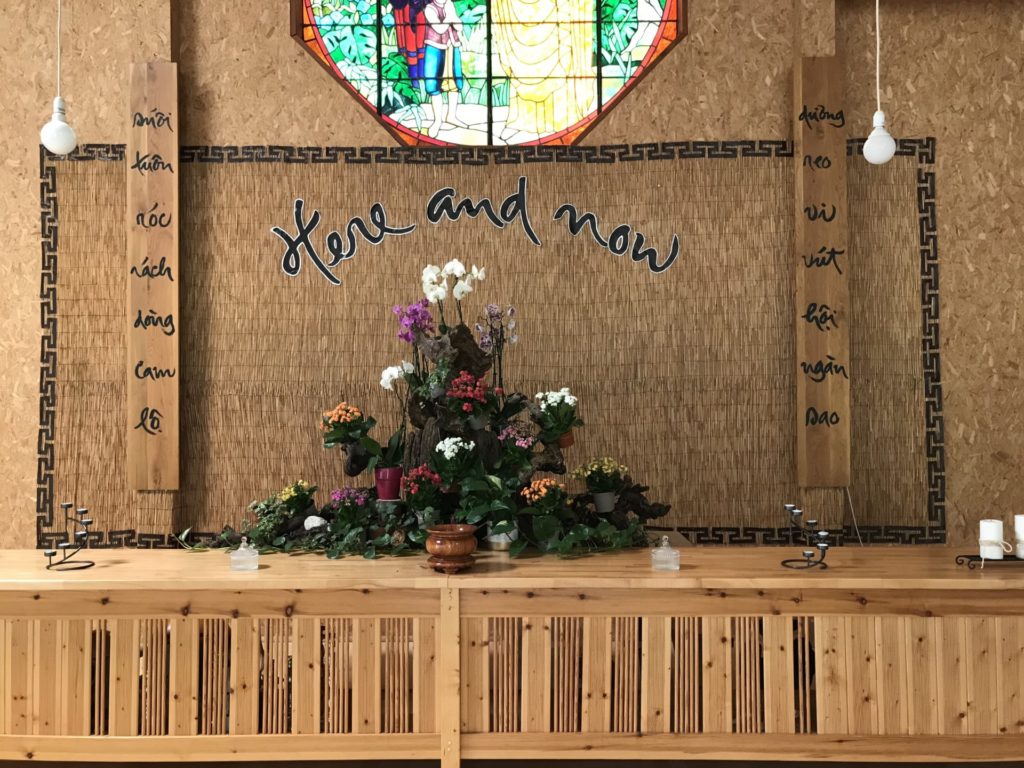
Commentary from Sister Hoi Nghiem
Our teacher, Thay specially offered Lower Hamlet these two parallel verses for the Vietnamese New Year in 2012. These two verses contain the names of the Meditation Hall and the Temple located in Lower Hamlet. The temple of Lower Hamlet is called the Dharma Nectar Temple, and the meditation hall (also located within the Temple) is called the Assembly of Stars Meditation Hall. These sentences can be seen parallel to each other upon the entry to the Assembly of Stars meditation hall. But of course, when Thay offers us a poem, he is also offering us gems of inspiration to enhance our practice.
Both sentences invoke beautiful imagery. Poetry is the art of arranging words, it has the power to awaken profound feelings in the reader. This is truly a gift to us.
The bubbling creek, stream of Dharma Nectar (Suối tuôn róc rách dòng cam lộ)
When in the presence of a creek, hearing the bubbling sounds of water flowing and seeing it flow over rocks offers us opportunities to stop, relax and enjoy the coolness of its quiet peaceful beauty. We want to stay there to enjoy it as long as possible. The creek is always there; the question is, are we present for the creek? Or are we preoccupied with other plans, worries, sorrows, and anxieties? Can we become fully present to hear all the riches the creek is offering?
Within each of us there are many creeks, the creek of compassion, understanding, joy….. We can practice in such a way that all the creeks within us remain fresh, alive, fluid, and unencumbered. The regular practice of going back to ourselves helps us to generate and maintain the wellbeing of our creeks. Understanding, and taking the time to go back to ourselves, being fully present helps elevate our Dharma Nectar stream. If we become thirsty, drinking a few drops of Dharma Nectar quenches our thirst immediately. The reason we cultivate our creeks is to build the stream of Dharma Nectar within us, first for ourselves and ultimately to offer it effectively to others.Thay used to remind us of that quite often. Therefore, as we practice with the bubbling creek, the stream of Dharma Nectar is alive, thrives and is readily available to partake from.
Rustling of the willow, an assembly of thousands of stars (Dương reo vi vút hội ngàn sao)
The imagery of the rustling of willow trees and an assembly of thousands of stars are images that take your eyes and heart up and out. The beauty that surrounds us and that is in us, is as high as the sky and is as mesmerizing as the numerous assembled stars, yet by being distracted we can completely miss it. And we also miss the calm, the space, the immensity and the connection that stars offer us.
‘Rustling of the willow, an assembly of thousands of stars‘, invoke images and sounds to remind us to be present and commune with nature at night. Solitude and rejuvenation can be found in the company of the rustling willow, and under the assembly of thousands of stars.
Buddha Hall (New Hamlet)
On a white lotus throne, the Tathagata appears, In the midst of the violet bamboo forest, Avalokiteshvara dwells. Trên đài sen trắng Như Lai hiện Giữa rừng tre tím Quán Âm ngồi.
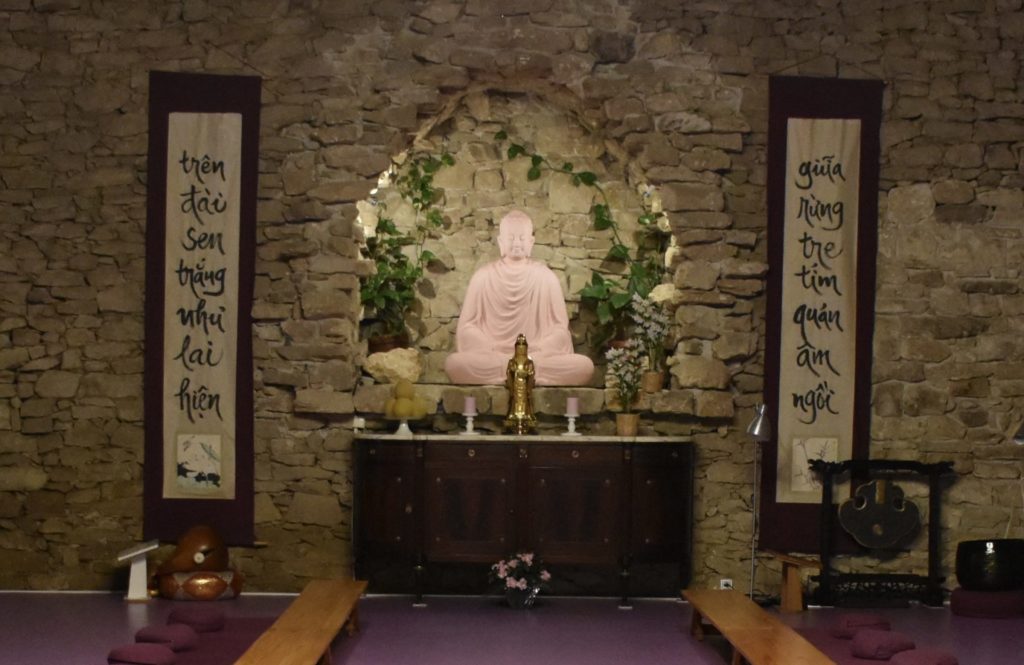
Commentary by Sister Dinh Nghiem
In 1997, about one year after Plum Village acquired New Hamlet, Thay arranged for the Buddha Hall to be reconstructed. He chose the color purple for the carpet. The New Hamlet sisters then sewed purple covers for the mats and cushions. When the Upper Hamlet and Lower Hamlet brothers and sisters came to New Hamlet for the next Day of Mindfulness, they teasingly called New Hamlet “Purple Hamlet”. This went on for a while until one day, I complained to Thay: “Dear Thay, why did you choose purple and now wherever we go, we are made fun of by the other hamlets?” Thay immediately opened a book in Chinese and pointed to me: “Don’t you know that Violet Bamboo Forest is the home of Avalokiteshvara? Violet is a very beautiful color.” A few days later, Thay brought to New Hamlet a pair of parallel verses that he had just written in calligraphy. The sisters set them to two long scrolls of purple fabric and hung them on two sides of the Buddha statue. They have remained there until today.
On a white lotus throne, the Tathagata appears (Trên đài sen trắng Như Lai hiện)
Whenever we set foot in the Buddha Hall and see the Tathagata sitting on the white lotus throne, our afflictions dissipate. The Tathagata is the energy of understanding, peace and solidity. He sits on the white lotus, fragrant and pure. But that lotus also grows from the mud, just as his understanding, peace and solidity are born from the experiences of suffering. If we know how to practise, we can use the mud to grow lotuses and enjoy the fragrant and pure lotus flowers. We can also transform our pain and suffering into understanding, peace and solidity.
In the midst of the violet bamboo forest, Avalokiteshvara dwells (Giữa rừng tre tím Quán Âm ngồi)
In front of the Buddha is Avalokiteshvara, the Bodhisattva of deep listening and great compassion. We listen in order to understand. Once we understand, we can accept and have compassion. Violet bamboo is a beautiful and rare kind of bamboo. Bamboos are resilient and their leaves are green all year round. They can persevere through storms and hurricanes without being struck down because of an interlaced root system that spreads and penetrates deeply into the earth, and because their stalk is slender yet supple by nature. Practicing listening in order to understand and to love as Avalokiteshvara does, we will be solid and capable of overcoming any difficulties we may have with our loved ones and everyone around us.
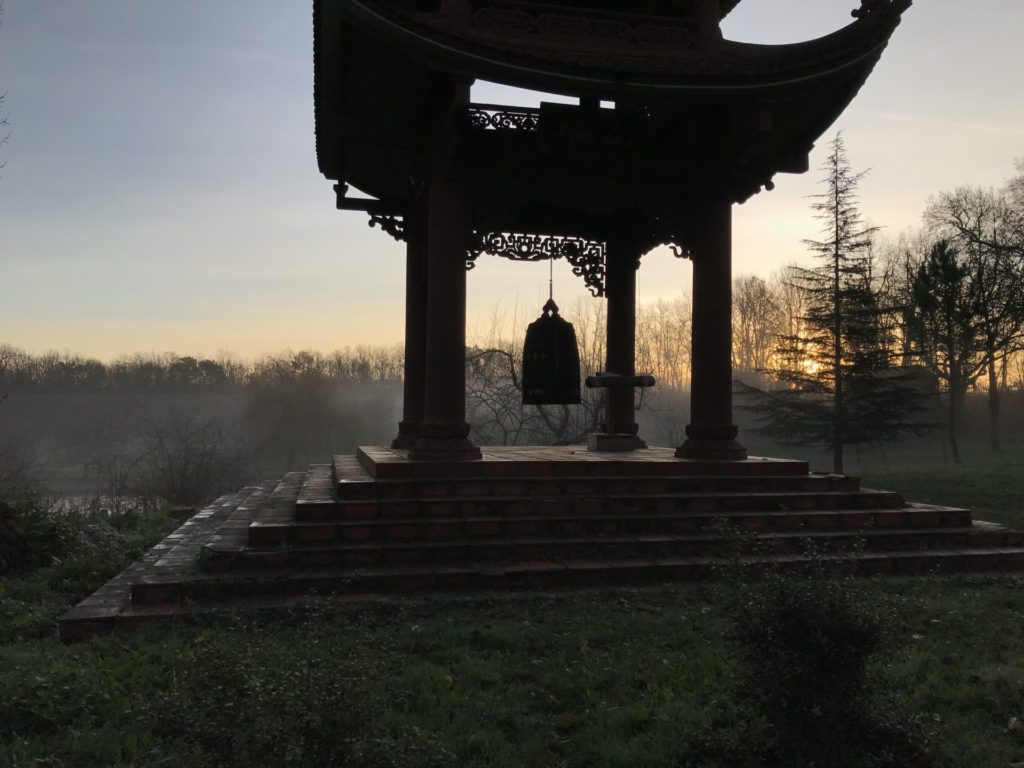
You may enjoy reading Part 2 of this article about the parallel verses of Upper Hamlet here.


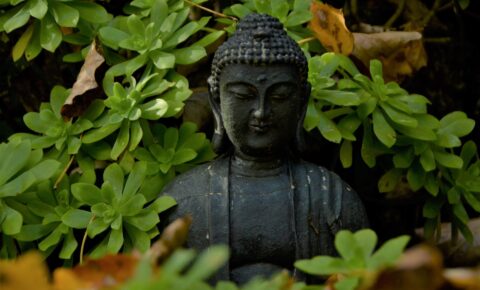


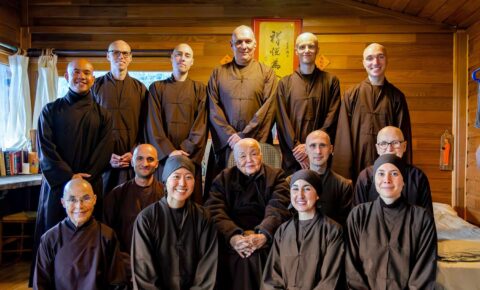
Join the conversation